- Home
- Medical news & Guidelines
- Anesthesiology
- Cardiology and CTVS
- Critical Care
- Dentistry
- Dermatology
- Diabetes and Endocrinology
- ENT
- Gastroenterology
- Medicine
- Nephrology
- Neurology
- Obstretics-Gynaecology
- Oncology
- Ophthalmology
- Orthopaedics
- Pediatrics-Neonatology
- Psychiatry
- Pulmonology
- Radiology
- Surgery
- Urology
- Laboratory Medicine
- Diet
- Nursing
- Paramedical
- Physiotherapy
- Health news
- Fact Check
- Bone Health Fact Check
- Brain Health Fact Check
- Cancer Related Fact Check
- Child Care Fact Check
- Dental and oral health fact check
- Diabetes and metabolic health fact check
- Diet and Nutrition Fact Check
- Eye and ENT Care Fact Check
- Fitness fact check
- Gut health fact check
- Heart health fact check
- Kidney health fact check
- Medical education fact check
- Men's health fact check
- Respiratory fact check
- Skin and hair care fact check
- Vaccine and Immunization fact check
- Women's health fact check
- AYUSH
- State News
- Andaman and Nicobar Islands
- Andhra Pradesh
- Arunachal Pradesh
- Assam
- Bihar
- Chandigarh
- Chattisgarh
- Dadra and Nagar Haveli
- Daman and Diu
- Delhi
- Goa
- Gujarat
- Haryana
- Himachal Pradesh
- Jammu & Kashmir
- Jharkhand
- Karnataka
- Kerala
- Ladakh
- Lakshadweep
- Madhya Pradesh
- Maharashtra
- Manipur
- Meghalaya
- Mizoram
- Nagaland
- Odisha
- Puducherry
- Punjab
- Rajasthan
- Sikkim
- Tamil Nadu
- Telangana
- Tripura
- Uttar Pradesh
- Uttrakhand
- West Bengal
- Medical Education
- Industry
Peroral endoscopic myotomy first line treatment option for achalasia

A new study published in The Lancet Journal suggests that for individuals with achalasia, peroral endoscopic myotomy should be suggested as a first line of therapy.
This randomized controlled trial's 2-year follow-up data revealed that peroral endoscopic myotomy, as opposed to pneumatic dilatation, is linked with a considerably better effectiveness as the initial treatment for therapy-naive individuals with achalasia. At the 5-year follow-up, Thijs Kuipers and team compared the treatment success rates for patients who underwent peroral endoscopic myotomy against pneumatic dilatation.
Six hospitals located in the Netherlands, Germany, Italy, Hong Kong, and the United States participated in a multicenter, randomized controlled study. Adults with newly diagnosed symptomatic achalasia between the ages of 18 and 80 were eligible for inclusion. Web-based randomization with an 8-person random block size and site-specific stratification was used to allocate patients (1:1) to pneumatic dilation or peroral endoscopic myotomy. Up to the official trial enrollment, the treatment type's randomization was double-blind. Because each technique uses a different technological method, the treatment might be revealed. Pneumatic dilation patients had a single series of 30-35 mm balloon dilations. Therapy failure was deemed to have occurred when patients in the pneumatic dilation group required further dilatations and patients in the peroral endoscopic myotomy group required dilatations following first treatment.
The key findings of this study were:
1. 182 participants were evaluated for eligibility between September 21, 2012, and July 20, 2015; 133 of these patients were included in the research and randomly allocated either pneumatic dilation or peroral endoscopic myotomy.
2. For 62 patients in the peroral endoscopic myotomy group and 63 patients in the pneumatic dilation group, 5-year follow-up information was available.
3. Treatment success at 5 years was achieved in 50 patients who had peroral endoscopic myotomy compared to 25 patients who underwent pneumatic dilation, an adjusted absolute difference of 41%.
4. Failures were attributed to repeated complaints, lack of an initial benefit from therapy, and one patient in the pneumatic dilation group who experienced an adverse event.
5. Patients who were still in clinical remission used proton-pump inhibitors more often (usually daily) after peroral endoscopic myotomy than after pneumatic dilatation.
6. Reflux oesophagitis was discovered in 14 (33%) of 42 patients in the peroral endoscopic myotomy group during a 5-year follow-up endoscopy of patients who were still in clinical remission.
7. Between 2 and 5 years following therapy, there were no significant adverse events connected to the intervention. Between 2 and 5 years, there were the following non-intervention-related major adverse events: one [2%] stroke in the peroral endoscopic myotomy group, one [2%] mortality from melanoma, and one [2%] dementia in the pneumatic dilation group.
Despite the fact that this study has revealed that peroral endoscopic myotomy has a higher long-term effectiveness and a lower risk of serious treatment-related problems, pneumatic dilation should still be used in clinical settings. Patients with achalasia who are treatment-naive should ideally discuss all available treatments, and a choice should be made together, advised the Authors.
Reference:
Kuipers, T., Ponds, F. A., Fockens, P., Bastiaansen, B. A. J., Lei, A., Oude Nijhuis, R. A. B., Neuhaus, H., Beyna, T., Kandler, J., Frieling, T., Chiu, P. W. Y., Wu, J. C. Y., Smout, A. J. P. M., & Bredenoord, A. J. (2022). Peroral endoscopic myotomy versus pneumatic dilation in treatment-naive patients with achalasia: 5-year follow-up of a randomised controlled trial. In The Lancet Gastroenterology & Hepatology. Elsevier BV. https://doi.org/10.1016/s2468-1253(22)00300-4
Neuroscience Masters graduate
Jacinthlyn Sylvia, a Neuroscience Master's graduate from Chennai has worked extensively in deciphering the neurobiology of cognition and motor control in aging. She also has spread-out exposure to Neurosurgery from her Bachelor’s. She is currently involved in active Neuro-Oncology research. She is an upcoming neuroscientist with a fiery passion for writing. Her news cover at Medical Dialogues feature recent discoveries and updates from the healthcare and biomedical research fields. She can be reached at editorial@medicaldialogues.in
Dr Kamal Kant Kohli-MBBS, DTCD- a chest specialist with more than 30 years of practice and a flair for writing clinical articles, Dr Kamal Kant Kohli joined Medical Dialogues as a Chief Editor of Medical News. Besides writing articles, as an editor, he proofreads and verifies all the medical content published on Medical Dialogues including those coming from journals, studies,medical conferences,guidelines etc. Email: drkohli@medicaldialogues.in. Contact no. 011-43720751


